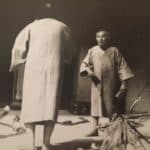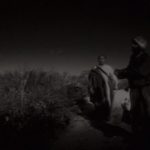Totò e Vicé. 1993.
directed by Antonella Di Salvo and Franco Scaldati
scenes Blasco Pitruzzella
costumes Laboratorio Femmine dell’Ombra
music consulting Gennaro Fucile
with Gaspare Cucinella, Antonella Di Salvo, Melino Imparato, Lucia Restifo Pecorella, Vito Savalli, Franco Scaldati
production Laboratorio Femmine dell’Ombra
premiere Gibellina, XII Orestiadi Edition of Gibellina, Case Di Lorenzo, 1-5 September 1993
Totò e Vicé, quadri d’universo
by Viviana Raciti
Franco Scaldati’s Totò and Vicé is the result of an assemblage of various texts, collected between 1993 and most probably no later than 1995. The archive contains a number of titles which were merged in the final text: Totò and Vicé (1993, shown at the Orestiadi Festival in Gibellina that same year); Totò and Vicé and the Angel of the Lanterns (1994), staged differently to the one above and presented with this title in 1995; Totò e Vicé are Really… two fireflies (1995), and Totò and Vicé Two Sugar-dolls and The Teacher and The Little Girl (both also from 1995). Two versions have been published of the text so far, the latter of which, though posthumous, was edited with the author’s permission and collaboration – it presents a number of variations in the placement and treatment of certain scenes.
Our object of analysis here however is the text’s first edition, published in 2003: this version more accurately reflects the author’s intentions for the text as it was being written and presented on stage, whereas its later edition tends to simplify some of its aspects, from the graphic presentation to the staging of certain scenes, to certain aspects of the language which appear thinned or clarified (for example the second edition cuts the ‘h’ in pupiddhu, Sicilian for ‘little doll’, which might appear look like an orthographic detail, but in fact signifies an important aspired ‘h’). In an interview with Valentina Valentini entitled ‘The Clear Shadow of Man’, included in the text’s first edition, Scaldati explains how Totò and Vicé were developed from two real-life characters who used to entertain people with crude and controversial fictional debates and staged arguments, for which they then asked for money, in the aftermath of WWII. Initially imagined by Scaldati in the 1980s as brief entr’actes to be interspersed through larger texts, in the 1990s the duo found an autonomous form.
Documents are published in original language. In case the translation is present, both the original and the translation are published.
Franco Scaldati, Totò e Vicé, extract. I and II part, in Valentina Valentini, Antonella Di Salvo (edited by), Franco Scaldati, Totò e Vicé, Soveria Mannelli, Rubbettino, 2003.
Sequences from Totò e Vicé, 1993
Orestiadi di Gibellina
Renato Tomasino, Angeli folli e sognatori, «Giornale di Sicilia», September 3, 1993
Roberto Giambrone, Le altre voci di Totò e Vicé, «il Manifesto», September 3, 1993
Elio D'Amico, Franco Scaldati nella veste di attore e autore alle Orestiadi con il dialogo metafisico e irreale di Totò e VIcé, «la Sicilia», September 5, 1993
Stefania Chinzari, Voci e canti color nostalgia per Gibellina, «l'Unità», September 20, 1993
Franco Quadri, Totò e Vicé uomini fatti di molliche di pane, «la Repubblica», September 5, 1994
Valentina Valentini, Introduzione. Totò e Vicé: coincidentia oppositorum, in Valentina Valentini, Antonella Di Salvo (edited by), Franco Scaldati, Totò e Vicé, Soveria Mannelli, Rubbettino, 2003.
Valentina Valentini, L'ombra chiara dell'uomo. Conversazione con Franco Scaldati, in Valentina Valentini, Antonella Di Salvo (edited by), Franco Scaldati, Totò e Vicé, Soveria Mannelli, Rubbettino, 2003.



